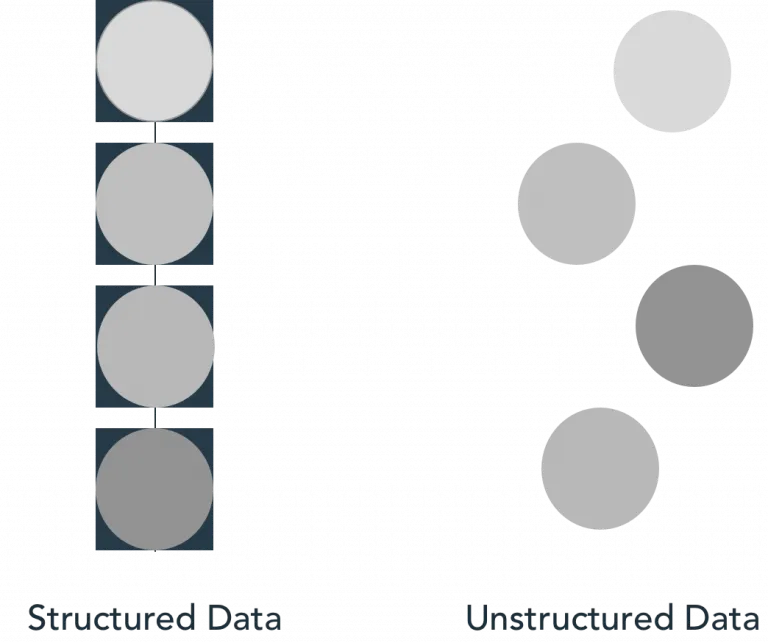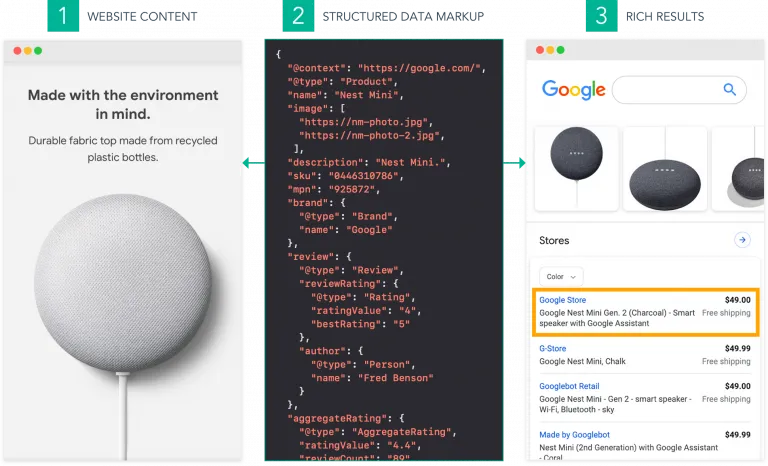Beginners Guide to Structured Data SEO
If you're a marketer, SEO, or someone that simply wants to improve their Google Search presence, then this short guide is for you. In this article, we'll explain what SEO is, why you should consider it vital to your online organic growth strategy, and help you understand some of the associated terminologies.
What is structured data?
Structured data, otherwise known as schema markup, is often referred to as the "language of search engines." It’s an authoritative vocabulary that makes it easier for search engines to contextualize, understand, and accurately match website content to relevant search queries.
What is the difference between structured data and unstructured data?

The difference is simple and intuitive. Structured data is organized data, whereas unstructured data is unorganized data. The following sentence is a good example of unstructured data:
"John Smith is a Software Engineer for Salesforce."
The reader, whether it is a human or robot, is required to independently classify all of this information. Structured data, by contrast, would organize all of these properties and types ahead of time. For example, "John Smith" is the name, "Software Engineer" is his role, and "Salesforce" is his company.
Why is Structured Data Important For SEO?

The internet is growing in size and complexity every day. Yet Google continues to have limited time and resources to pursue its mission of organizing the world's information in an easily accessible and useful way. It still struggles to serve the most relevant and helpful links to each query in its search engine. Structured data is important for SEO because it helps Google serve this mission more efficiently.
As previously mentioned, structured data helps a search engine understand your content better, which in turn helps them rank your content more accurately. This helps them present more information directly on the results page in the form of rich snippets . Not only do you improve the experience of the Search Bot, but you improve the user experience as well by improving the results page with more accuracy and more information for them to resolve their queries faster.

The Advantages of Structured Data:
- Search engines understand all the parts of your business, your brand, and your content better.
- Search engines match content more accurately to relevant search results.
- Search engines include more information on the search results page for your content, like cooking time from a recipe page, location from an event page, or a review from a customer success page.
- These improvements help Google build a better, more accurate knowledge graph and knowledge panel about your brand.
- These improvements can lead to more ranking keywords because search engines associate your content with more topics and sub-topics.
- These improvements can lead to more organic impressions and organic clicks because search features like rich results help your content stand out in search and resolve queries faster.
How Structured Data Improves On-SERP SEO
On-SERP SEO is the organic channel strategy of covering as much real estate as possible on the first search results pages for any of your target keywords in order to capture the attention and clicks of your target audience. This is done by qualifying for applicable SERP features, like Google Ads, Featured Snippets, Image Packs, and FAQs, in addition to ranking as highly as possible. Structured data improves On-SERP SEO by qualifying your content for over 30 rich results, also referred to as rich snippets, that maximize the functionality and visibility of your links with more actionable, appealing, and detailed information embedded directly in the search results. To see the impact in Google search, go Search Console and under Performance > Search Appearance, you can view a breakdown of all the rich result types like "How-Tos" and "FAQs" and see the organic impressions and clicks they drove for your content.

Want these benefits for your website?
Try our World-Class Automated Structured Data.
Is Structured Data a Ranking Factor?
Structured data is not a ranking factor YET, but it is highly recommended by Google developers and indirectly helps your website improve rankings.
To reiterate, by presenting information in a machine-readable context, Search Bots are able to understand the meaning of your pages, match content with more relevant queries, and display applicable rich results as well. These all have indirect effects on ranking factors like click-through rate and direct traffic because Google uses the data to put your links in front of more qualified audiences and those links are enhanced by features like FAQs, ratings, and reviews that help customers solve their queries faster and entice visits to your pages.
Regardless of the ranking question, if your goal is to increase visibility in the SERPs and indirectly influence rankings, it is a critical asset to have on your website.
What is Schema.org?
Schema.org is a community founded by the four major search engines - Google, Microsoft, Yahoo, and Yandex - with the intention of building a better semantic web by collaboratively developing schema vocabularies for structured data markup across the internet. A commonly used vocabulary in the form of schema.org types and properties makes it easy for marketers and website developers to participate in this initiative.
How Do You Implement Structured Data?
In order for structured data to be effective and recognized by search engines, and specifically by Google (international/worldwide market share of 87%), the structured data markup must describe the page content and include information that is visible to the user.
There are a number of ways that structured data markup can be implemented on a page but the recommended format is via JSON-LD.
JSON-LD is not meant to be seen by humans – it is designed for search engines. JSON is the text format and LD stands for linked data that allows you to express data in a way that is more precise to the individual entities. Think of it as a book. It’s written in a way you can map objects over pages. There is no parsing, guesswork, or filtering that needs to be done by search engines. Everything is very explicit – what you say means only what you say. It’s the cleanest way to communicate and that’s why Google prefers it and recommends it to SEOs.
There are other methods, including microdata, microformats, and RDFA, but these alternatives are mixed in with content shown to users which can complicate the goals of expressing data to search engines and providing a top-notch user experience. For the alternatives, like microformats, it’s like adding subtitles or creating transcriptions to something somebody wrote and hiding it in the HTML for Google to extract and decipher.
JSON-LD vs Microdata:
Which Type of Structured Data Should I Use?
Google supports both JSON-LD and Microdata structures. JSON-LD, a more lightweight solution, is Google's preferred data format.
From our perspective —and Google’s— there’s a clear winner: JSON-LD. It’s the most elegant and lightweight solution for structured data markup.
JSON-LD is a Javascript notation that annotates web content and can be templated across web pages, making it easy to add, edit, and remove. It’s not mixed in with user-visible text, and there’s no need to alter existing HTML tags — simply add JSON-LD to the script tag in your page head or body.
Example of how JSON-LD appears:

Microdata is a way to label various HTML elements on a page using machine-readable tags. Because microdata is embedded within the HTML source code of a web page, it takes more time to implement and is more difficult to edit and remove.
Example of how Microdata appears:

Additional Tools and Resources for Structured Data
Want to dive deeper into structured data? We’ve compiled our favorite learning resources, tips, and SEO tools to test your structured data and learn more about the basics of the implementation process.
- Google Structured Data Testing Tool
- Google Structured Data Markup Helper
- Google Rich Results Testing Tool
- Google Codelab Structured Data Tutorial
- Google Guide: Understand How Structured Data Works
- Schema.org
- Huckabuy Structured Data
Structured Data Glossary
HTML
Hypertext markup language. HTML controls how a web page is structured (headings, paragraphs, etc.) and what it says (text).
Javascript
A computer programming language used to create interactive/dynamic action on a website.
JSON-LD
JavaScript object notation for linked data. Google’s preferred format for structured data.
Knowledge Graph
In the context of SEO, a knowledge graph pulls information from a variety of sources, such as the CIA World Fact Book and Wikipedia, and presents them in knowledge panels located on the the right hand rail of search results pages.
Microdata
A way of annotating HTML elements with machine-readable tags, microdata is another type of format for structured data.
Open Graph
Integrates website content with social media platforms, like Facebook and Twitter, by tagging content such that it can be presented and shared in a native format alongside other objects on those platforms.
RDFa
Resource description framework in attributes. Another format for structured data.
Rich cards
A separate result, often with visual enhancements, appears at the top of a search results page.
Rich results
An umbrella term that includes all types of search result features and enhancements.
Rich snippets
Any type of organic search result listing with enhanced information displayed alongside the url, title, and description. Sometimes used interchangeably with "rich results".
Schema markup
Another way of saying structured data.
Schema.org
An extensive labeling system, created by the major search engines in 2011, that standardizes how web content is marked up. This shared vocabulary makes websites easier for search engines to understand.
Search bots
Search engine crawlers (also known as spiders) that go through the Internet to find content. Each search engine has its own name for its bots: Googlebot, Bingbot, etc.
SERP
Search engine results pages.
Structured data
Endorsed by Google, structured data is the language of search engines. It explicitly tells them what is on a webpage so they can properly understand and contextualize content.
Structured Data Articles
Structured Data & Schema.org
What is structured data and schema.org?
Schema.org is a community founded on June 2, 2011 by Google, Microsoft, Yahoo, and Yandex with the initiative of collaboratively developing schema vocabularies for structured data markup on web pages, emails, the internet, and more. This shared vocabulary creates ease for marketing and website developers to maximize their efforts and the benefits of those efforts.
What are the benefits and guidelines of structured data?
To help search engines in understanding each page on your site, you should implement structured data (SD) to provide context to the site’s content in an authoritative way. Read more to learn why you need to get SD on your site (the benefits) and to learn about the general guidelines of SD markup.
Understanding the Structured Data View in the Huckabuy Dashboard
How do I use the structured data page in the Huckabuy Dashboard?
In order to get full value out of our Dashboard, it’s important that you as a customer can understand the information being presented to you when you navigate to the different views available within it. Once you have installed Huckabuy SD markup to your website, you will be able to keep track of the number of structured data objects you currently have in use. This article will explain how to navigate the structured data page in the dashboard and export reports.
How to track SD/Rich Result performance in GSC
How can I track structured data and rich results performance in Google Search Console?
Structured data markup is used to help search engines understand the content and information on a website. The Huckabuy dashboard monitors the health of structured data markup objects and tracks the SEO performance of your website in correlation with Huckabuy structured data markup. Also, the dashboard tracks the performance of rich results connected to your site. Read more about how to track SD and rich results performance for your business in this article.
Duplicate Structured Data Removal
Why should I remove duplicate structured data and how do I do it?
As the importance of SD and the understanding of its value has grown, so has the growth of SD tools. It is crucial to avoid the duplication of SD markup on pages and the generation of it from many sources. As a customer of Huckabuy’s SD software, you are buying the most robust SD for your site, and you want to make sure that you don’t have any duplicate SD from other SEO tools or plugins. Read more to discover how to detect and remove duplicate SD from your website.
Google’s Recommended & Required Data Attributes
What are Google’s recommended and required data attributes?
Although Google uses Schema vocabulary, it has also created its own set of recommended and required properties. Each structured data object has a unique set of recommended and required properties, all depending on the type of content and information it is providing. Read more about Google’s recommended and required data attributes.
Schema Object Types & Rich Result Eligible Object Types
What are schema object types and rich results eligible object types?
Schema is a language that webmasters can implement onto a website to help search engine spiders understand web content more easily. Schema.org’s vocabulary currently (early June 2020) consists of 829 object types, 1,351 properties, and 339 Enumeration values; each object type is categorized in a hierarchy with various properties associated with the object type. New schemas are being created all the time with the goal of creating the most detailed and descriptive vocabulary. This article lists current eligible schema object types and rich results/rich snippets object types.